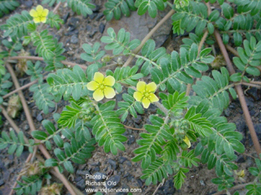Puncturevine is an invasive plant in the western United States. Common names include Puncturevine (Tribulus terrestris L.), and Goathead. The plant is a native to Southern Europe and Asia and was originally imported accidentally into the United States and Canada and seeds quickly spread.
The plant lives in a crop fields, pastures, along roadways and railways, in waste places, walkways, parks, yards, and other disturbed areas. It grows best on dry sandy soil, but will tolerate other types of soil.
Much of the information contained in this description was adapted from the Early Detection and Rapid Response Factsheet – Randy Westbrooks, USGS.
Figure 1. Puncturevine leaves. Photograph: Randy Westbrooks, US GS

One page educational fact sheets can be downloaded here:
Puncturevine Early Detection Rapid Response Fact Sheet
Puncturevine (a.k.a. Goathead) Fact Sheet
Legal Status:
This plant is on the Idaho State Noxious Weed list and as such landowners are required by state law to control noxious weeds.
Identification
Puncturevine is an herbaceous perennial, patch-forming plant, with a deep taproot (up to 9’); an annual in colder climates. Branching stems radiate from the crown to a diameter of 2-5’. Leaves opposite, hairy, 1-3” long, pinnately compound, with 3-7 pairs of leaflets. Flowers yellow, with five petals, 0.5” wide, developing singly in the leaf axils. Fruit a round, spiny bur that splits into 4-5 hard burs. Burs with 2-3 sharp spines, enclosing the seeds. Seeds viable in the soil for 3-7 years.
Figure 2. Puncturevine or “goathead”. Photograph: Richard Old

Nez Perce County Distribution:
Puncturevine has been located in the City of Lewiston, along the stream at Mission Creek, Lapwai Creek, Garden Gulch and Tom Beall Creeks. Control efforts focus on injecting the stems.
Impacts:
- The hard, spiky seed case can injure livestock, people, and pets when stepped on and can puncture bicycle and car tires.
- A problem in orchards, turf, pastures, and recreational trails.
Biology:
- Puncturevine is a herbaceous perennial, this means that the plant dies down to ground level each winter and lasts for an indefinite number of years.
- The main way in which it spreads is by human activity.
- Puncturevine, when untreated, develops a thick mat that hides the sharp burs.
- Plants grow up to 10 feet tall.
- Plants begin flowering mid-summer and seeds then germinate in 2-3 weeks.
CONTROL
Puncturevine is difficult to control. Landowners should refrain from cutting or digging as the plant can regenerate from a single piece. The most effective means of control is through herbicides. The District has an on-going control program within the Lapwai Creek watershed.
References:
Puncturevine (a.k.a. Goathead) Fact Sheet. Salt Lake County Weed Control Program. Salt Lake County Website
Westbrooks, R. G. (n.d.). EDRR Fact Sheet. Whiteville, North Carolina, USA: U.S. Geological Survey.